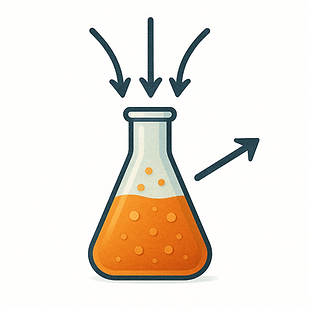


subCULTIVATOR
The ultimate system for:
-
Adaptive Laboratory Evolution
-
Strain development
-
Microbiological adaptations and investigations

Subcultivations automated: impeccable timing and precision, unparalleled speed and reproducibility.

how it works

A simple set up is all it takes to run a walk-away protocol with the subCultivator and admire the results.
A traditional series of flasks is replaced by a single mini bioreactor, connected to one outlet and three inlet syringe pumps.
Subcultivation triggers can be defined as time, OD or fluorescence. For each subcultivation, media composition and process parameters can be defined, allowing fully automated strain development and microbial investigations.


The subCultivator is capable of running a large range of processes: batch, fed batch, continuous, chemostat, turbidostat as well as subculturing bioprocesses.
capabilities

EXAMPLE 1: Cultivation of riboflavin producing strain in subcultivating and turbidostat modes (holding OD 0.4 and OD 0.8). Riboflavin exhibits fluorescence with an emission peak at 590 nm.
This expetiment showcases the characteristics of riboflavin production in subcultivation and turbidostat modes. The production is stable in subcultivation mode, however undulations in production are noticable when the system is set in turbidostat mode at OD 0.4. Furthermore, increasing the holding OD to 0.8 enhances the production 1.5 fold.
An interesting phenomenon appears after the turbidostat OD is shifted from 0.4 to 0.8: the 515 nm fluorescence signal decreases significantly, indicating a significant change in the microorganism's metabolism.

EXAMPLE 2: Cultivation of RFP-tagged protein producting strain in subcultivating mode.
An increase in growth rate can be spotted already in the third generation (shorter peak to peak/subcultivation times), indicating an adaptation of the strain to the media. The experiment also shows the stabile integration of the protein sequence into the host genome, as the fluorescence intensity is not decreasing with subcultivations.
reactor

• 2 & 25 mL options
• Multi-use, autoclavable
• Biofilm resistant, optically transparent
• With breathable or sealed cap for aerobic and anaerobic cultivations
• Magnetically stirred
• 4 ports (1 outlet, 3 inlets)
• Glass mini bioreactors available

sensors
• Biomass (OD): accuRead, transmittance-based OD600 detection
• Fluorescence: fluoRead, 447 nm excitation laser combined with a spectrophotometer

fluidics
4 SYRINGE PUMPS FOR LIQUID HANDLING
• 1 outlet & 3 inlet high precision Essi Syringe pumps for media variations of subcultivation sequence
• Compatible with 10 & 50 mL autoclavable syringes or single use 20 mL plastic syringes
• Automatic syringe refilling solution available

applications
BIOPROCESSING
o Batch, fed-batch and continuous
o Chemostat and turbidistat
ADAPTIVE LABORATORY EVOLUTION
o Adaptive strain improvement by incremental increases of stressor concentration
o Adaptations to process environment
MEDIA SCREENING
o Automated growth & production investigations
DEFINE TRIGGERS
o Time
o Biomass (OD)
o Fluorescence
DEFINE PARAMETERS
o Incremental increases in media composition
o Import a table of bioprocess parameters including media compositions
control

ODdock software

features
widely applicable
-
Our detection systems work for all microorganisms, including filamentous ones

easy installation
-
All systems are safe and very easy to install in most shaking incubators
-
Systems are designed to allow autoclavability of culture vessels

adaptable
-
All systems are suitable for aerobic and anaerobic cultivations
-
Vessel sizes are adaptable upon request

easy data handling
-
Data acquisition is handled by intuitive softwares
-
The saved data can be directly opened with Excel, Notepad etc.
